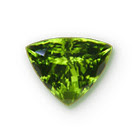Peridot is the birthstone for the month of August. Peridot is an ancient and yet currently very popular gemstone. It is so old that it can be found even in Egyptian jewelry from the early second millennium BC. The stones used in those days came from an occurrence on a little volcanic island in the Red Sea, about 70 km off the Egyptian coast, which was rediscovered only around 1900 and has been completely exploited since. Peridot, however, is also a very modern stone, for only a few years ago Peridot occurrences were discovered in the Kashmir region, and the stones from there show a unique beauty of color and transparency, so that the image of the stone, which was somewhat dulled over the ages, has received an efficient re-polishing.
Peridot is one of the few gemstones which exist only in one color and yet the gemstone is actually known under three names: Peridot, Chrysolite (and derived from the Greek word “goldstone”) and Olivin, because Peridot is the gemstone variety of the Olivin mineral. In the gemstone trade it is generally called Peridot, a name derived from the Greek “peridona”, meaning something like “giving plenty”.
When I think on Peridot I'm reminded of some things about Jesus. Peridot exists in only one color and yet is known by three names. This reminds of the Holy Trinity (Father, Son, and Holy Spirit) that we believers know as One God. The root of Peridot's name "giving plenty" and color of yellow/gold and green reminds me of what Jesus said in John 10:10, "The thief comes only to steal and kill and destroy; I came that they may have life, and have it abundantly"NASB.

"Giving plenty" makes me think of that word "abundantly". The yellow/gold of the color makes me think of blessings (like gold, or riches), and green obviously makes me think of life itself...everlasting life which He purchased for us at Calvary with His Life and Blood.....now that's giving plenty!
NEXT POST: *The Gems of Exodus and Revelation - Chrysolite
*The Gems of Exodus and Revelation are presented in twelve monthly installments and will explore the similarities between the stones in the ephod (breastplate) of Aaron and the stones of the New Jerusalem, and their relation to Jesus.




No comments:
Post a Comment